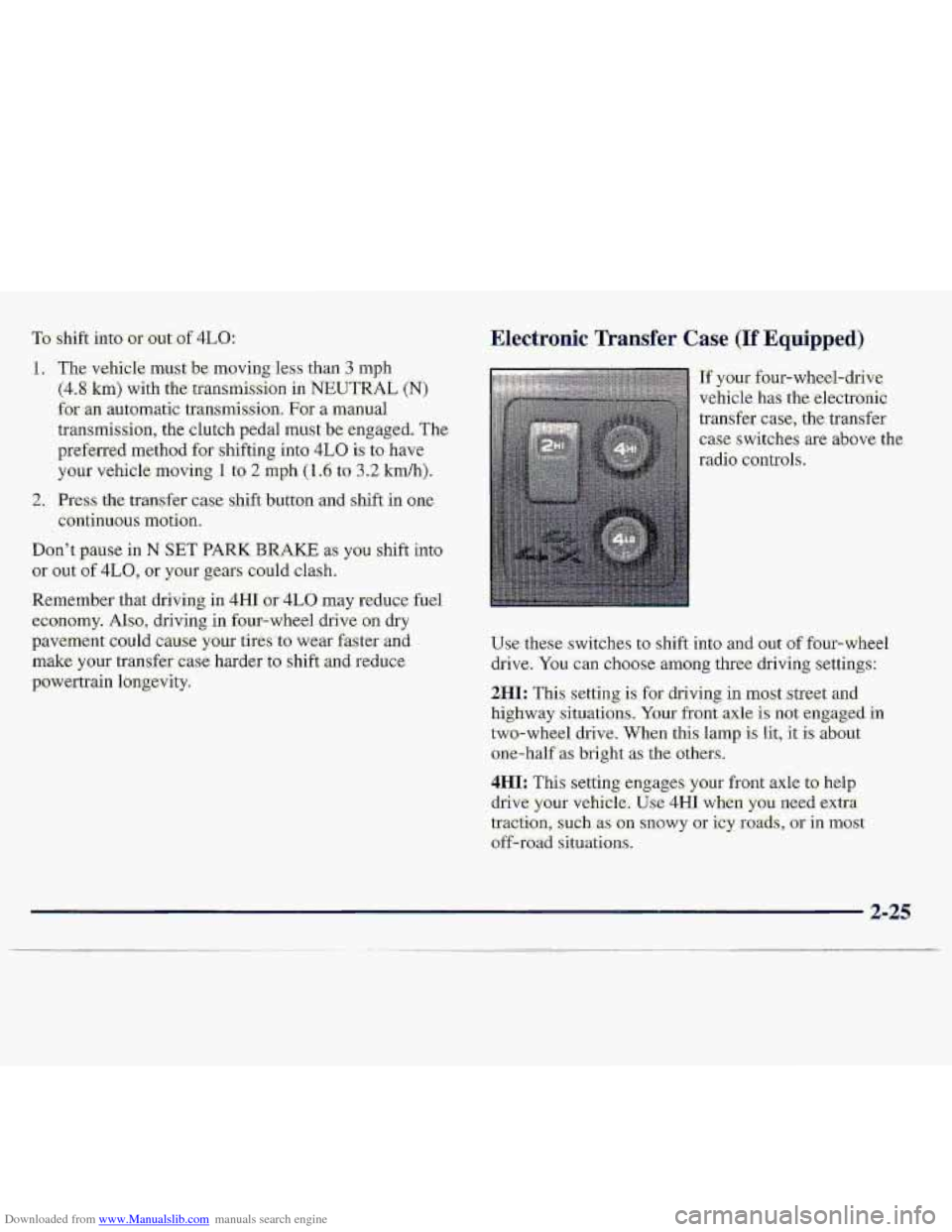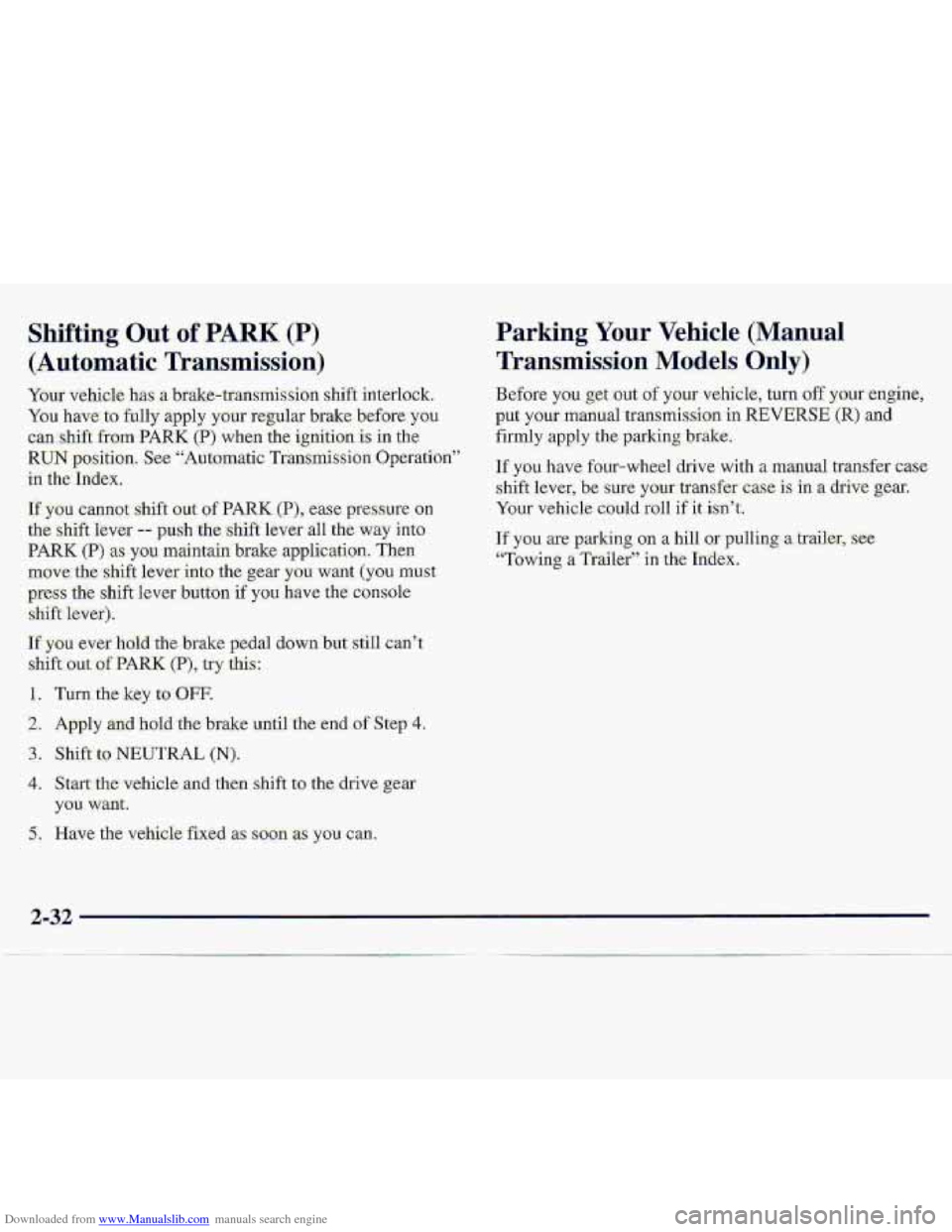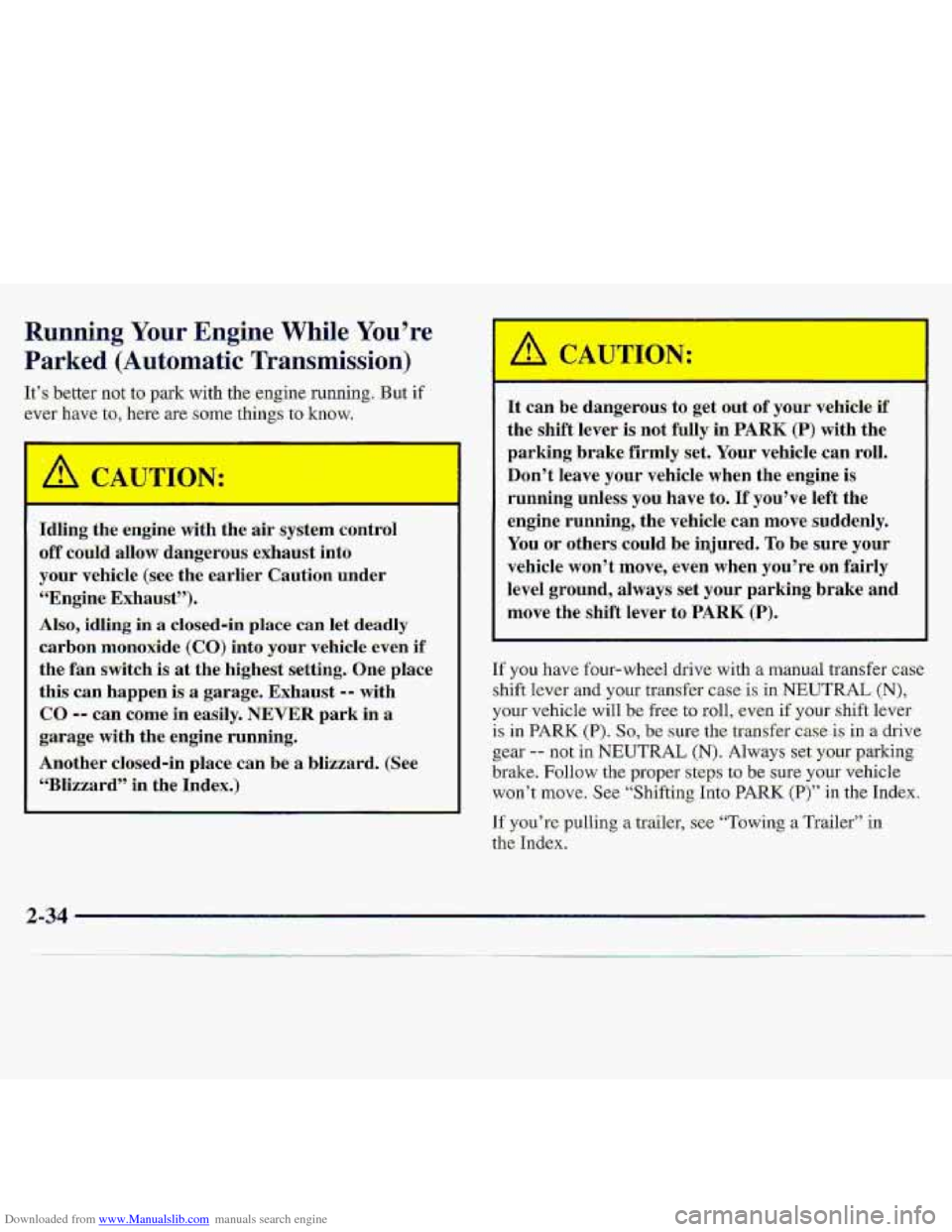Page 72 of 402

Downloaded from www.Manualslib.com manuals search engine TO shift into or mt. of 4LQ:
1. The-vehicle myst be movingless than 3 mph
(4.8 h) with the tfansrnissi-on in NEUTRAL (N)
fa an automatic transmisSion. Fm a n~anual.
transmission, the clutch pedal must
.be engaged. The
p-referred method for shi€tin.g into 4LO is to have
your vehicle moving
1 to 2 mph (1.5 to 3.2 Wh).
2. Press the trans€er case s:hi€t buttan .and shift in one
continuous motion.
Don't pausejn
N SET PARIK;BRAKE as y-ou shift into
or out of 4L0, or your gears could clash.
Remember that driving in 4HI ur 4LO may reduce fuel
ec-onomy.
Also, driving in fo.ur-whee1 drive:on dry
pavement could cause your tires to wear faster and
make your transfer case harder to shift and-reduce
powertrain longevity.
Electronic Transfer. Case (KEquipped)
I~y~~~-four-wheel-drive
vehicle
has the electrofiic
transfer
case, the transfer
case switches are above the,
radio controls.
Use these switches to shift into and out of four-wheel
drive.
You can choosea-rmng three driving settings:
2M[: This setting- is for driving in most .street and
highway situatibns ... Your front axle is not engaged in
two-wheel drive. When this. lamp is lit, it is about
orre-half as bright as the Others.
4HI: This setting engages your front axle ta- help
drive,
your vehitk. Use 4Hi when YOU. need extra
traction, such as
on snowy or icy rcmds, or in mast
off-road situations-.
Page 75 of 402
Downloaded from www.Manualslib.com manuals search engine Parking Brake
I NOTICE: I
Driving with .the:p.arking brake on c=an.cause
your- rear brakes to overheat. Y0.u may have to
replace them, and you. could .also-damage other
parts of your vehicle.
If you. are towing a trailer and.you must. park on a hill,
see--"Towing a Trailer" in. the Iadex. That section shows
what to
do first- to. ke.ep the trailer from moving.
Page 76 of 402
Downloaded from www.Manualslib.com manuals search engine Shifting Into PARK (P) (Automatic
Transmission Models Only)
It can be dangerous to get out of your vehicle if
the shift lever is not fd1y in PARK (P) with the
parking brake firmly set. Your vehicle can roll.
If you have left the engine- running, the vehicle
can move suddenly. You or others could be
injured.
To be sure your vehicle won’t move, even
when you’re on fairly level ground, use the steps
that follow.
If you have four-wheel drive with
a manual transfer case-shift lever and your
transfer case
is in NEUTRAL (N), your vehicle
wiIl be free to roll, even if your shift lever is in
PARK (P). So, b.e sure the trans€er case is in a
drive gear -- not in NEUTRAL (N). If you’re
pulling
a trailer, see CLTowing a Trailer’’ in
the Index.
Column Shift Lever
1. Hold the brake pedal down with your right,foot and
2. Move the SM lever into PARK (P) position like this:
set the parking brake.
1 I
Pull the lever toward you.
2-29
Page 77 of 402
Downloaded from www.Manualslib.com manuals search engine Move the lever rjp as far as it will ga:
.3. If you have four-wheel drive with a manual .transfer
case shiftleverj be sure the transfer case is in a drive.
gear
-- not in NEUTRAL (N).
4. Turn the ignition key to LO-CK.
5. Remove the key and take it with you. Fyou c.an
remove the key from your ignitibn, your vehicle is in
PARK (P),
Console Shift Lever
1. Hold the bvake pedal dawn with your ri,ght foot and
2. Move the -shift .lever into PARK (PI position like this:
set the ,parking brake.
0 Hold in the button on the lever.
0 Push the lever abbe way towd the front of
t-he. vehicle.
3. Turn the ignition key to LOCK.
4. Remove the key and take it with you. If y0.u can leave
your vehicle
with the key, your vehicle is in PARK (P).
2-30
Page 78 of 402
Downloaded from www.Manualslib.com manuals search engine Leaving Your Vehicle With the Engine
Ru-ming (Auto,matic Tra mission
Models Only]
It can be dangerous to leave ; LXF -vehicle with the
engine- runnin.g. Your vehicle could move: suddenly
if
the shift lever is 'not fuUy in PARR (P) with the
parking brake. firmly set. If you: have fo-ur-wheel
drive
w.ith a manual transfer case shift lever and
your transfer caseis in
NEUTRAL (N), your
vehicle. will be free to roll, even if your shift lever
is-in PARK (P). So be sure- the transfer ,case.is in a
drive .gear -- not in NEUTRAL (N). And, E you
leave. the .vehicle with the engine running; it could.
overheat and even catch fire. You or others could.
be injured. Don'? leave your vehicle with the
engine rummg. unless you have to.
Page 79 of 402

Downloaded from www.Manualslib.com manuals search engine Shifting Out of PARK (.P)
(Automatic Transmission)
Your vehick has a brake-transmission shift biterlock.
You have to fully apply your regular brake before. you
can :.shift from PARK (P) when the i-gnitlon is in the
RUN position. See- “Automatic Transmission Operation”
in the Index,
If you cannot shift out of PARK (P), ease pressure on
the shift lever -- push the shift lever all the way into
PARK (PI as you maintain brake application. Then
move the shift lever into the gear you want (you must
pms the shift lever button if you have the. console
shift lever).
If you ever ho1.d the brake pedal down but still can’t
shift out
of PARK- (P), try this:
Par g, Your Vehicle (M-anual
Transmi,ssion Models Only)
Before you-get out of your vehicle, turn off your engine,
put
y.0~11- manual transmission in REVERSE-(R) and
firmly .apply the parking bzakei
If you have four-wheel drive with a manual transfer case
.shift lever, be sure
your transfer case is in a drive gear.
Your vehic1.e
could roll if it i.sn’t.
If you are parking on a hill or pulling a trailer, see
“Towing a Trailer” in the Index.
I. Turn the key to OFF.
2. Apply and ho-18 the brake until the end of Step 4.
3. Sliiffto NEUTRAL (N).
4. Start. the vehicle and then shift to the drive gear
5. Have the vehide fixed as soon as you can.
you want.
2-32
Page 81 of 402

Downloaded from www.Manualslib.com manuals search engine Running, Your Engine While Yo-u’re
Parked (Automatic Tr-ammission)
It’s better not to park with the -.engine running. But if
ever have to, here are some things to knbw.
Idling the engine with L; air system control
off could allow dangerous exhaust into
yom.-vehicle (see the ear1ie.r Caution under
“Engine Exhaust”).
Ab, idiirig-in a. closed-ili place can let deadly
carbon monoxide
(Ca) into y.our vehicle even if
the fen switch is at the highest Setti.ng. One place
this can happen
is a ,garage. Exhaust -- with
CO -- can come in easily. NEVER park in a
,-garage with th-e engine runnihg.
Another cl~sed-in place
can be a. blizzard. (S.ee
“Blizzard” in the Index.)
r
It can be dangerous to get aut.of your vehicle if
the shift lever is not fully in PARK (P) with the
parking brake-firmIy set, Your vehicle c.an roll.
Don’t leave your vehicle when the engine is
running unless you have
to. If you’ve left th.e
engine runnhg, the vehicle can
move suddenly.
You
or others. could be injured. To be sure your
vehicle won’t move, even when you’re bn fairIy
level ground, always set your parking brake -and
move the shift 1-ever-to PARK (P).
If you have four-wheel drivecwith a manual transfer case
shift lever and your tKans-fer case .is in.NErJTRAL. (N),
your v8hicle will be free to roll, even if your shift lever
is in PAR.K (P). So, be sure the tran-sfer c.ase is in a drive
gear
-- not in NEUTRAL (N). Always-set y.our-p.arking
brake.
Follow the proper steps to be sure your vehicle
won’t move. See “Shifting Into PARK.(P)” in the Index.
If you’re pulling a.trailer, see “Towing a Trailer” in
the Index.
2-34
Page 87 of 402
Downloaded from www.Manualslib.com manuals search engine Cruise Control (If Equipped)
-With cruise control, you can
.maintain a speed of about
25 mph (40 km/h) or more
without keeping your foot
on the-accelerator. This can
really help on long trips.
Cruise control does not
work-at speeds belo-w about
25 mph (4.0 kdh).
If you have an automatic transmission and y.0~ apply
your brakes, the cruise control will shut off.
:If you have a manual transmission and you apply your
brakes
or push the clutch pedal, the cruise control will
shut off:
@ Cruise control can be dangerous where you
can’t drive safely aka steady
speed. So,
don’t use your cruise control on winding
roads or in heavy traffic.
slippery
roads. On such roads, fast changes
in
tire traction can cause needless. wheel
spinning, and you could lose control. Don’t
use cruise control on slippery
roads.
a Cruise control can be dangerous on
2-40